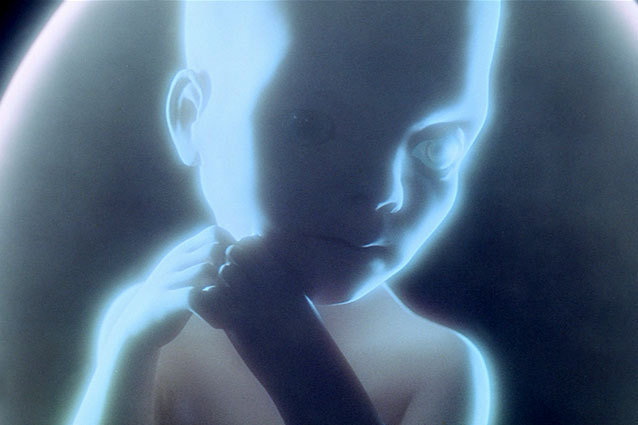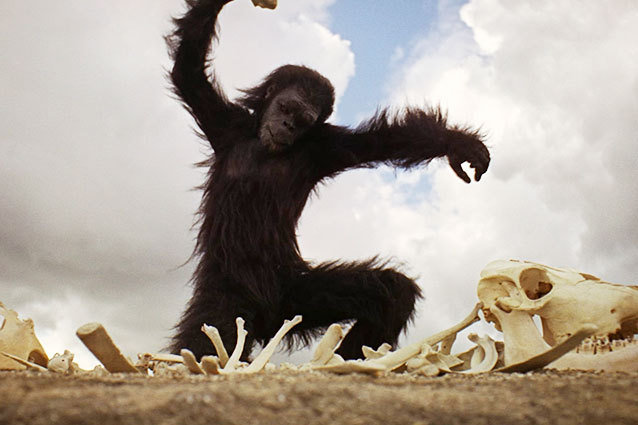
What more can be said about 2001: A Space Odyssey? This month celebrating its 45th anniversary, it’s one of the most influential science fiction films ever made — with its DNA spliced and replicated in a host of other films from Blade Runner to Inception — despite being so very singular. It transformed sci-fi from the sex-and-monsters exploitation schlock that glutted the genre in much of the ‘60s and showed that sci-fi could be transcendent and spiritual. It baffled many upon its first release — Pauline Kael and Stanley Kauffman were among its high-profile detractors, while Steven Spielberg called it the “big bang” for his generation of filmmakers. Its meanings have been so endlessly scrutinized and dissected that any further analysis seems redundant. And yet, there are so many details about its origins, production, and initial release that you probably don’t know. Here are 20 things about 2001: A Space Odyssey that we’re guessing you’ve never heard of before. You’re welcome.
1. Though 2001: A Space Odyssey and the novel of the same title were conceived at the same time, Kubrick didn’t think at first that sci-fi novelist Arthur C. Clarke would be willing to take on the job. The science fiction writer was living in Ceylon (now Sri Lanka) and was thought to be a recluse. When his agent telegraphed him about the offer to work on Kubrick’s project, Clarke’s response was, “Frightfully interested in working with enfant terrible… what makes Kubrick think I’m a recluse?”
2. Alternate titles considered for the project early on were Journey Beyond the Stars, Universe, Tunnel to the Stars, Planetfall, and How the Solar System Was Won. The last was a reference to MGM’s 1962 epic Western How the West Was Won, which 2001: A Space Odyssey was originally going to copy by using that film’s three-camera super-widescreen Cinerama format.
3. Though the 2001: A Space Odyssey novel, released shortly after the film in 1968, only listed Clarke as its author, originally, the film’s screenplay was going to be credited to “Stanley Kubrick & Arthur C. Clarke,” while the novel would list “Arthur C. Clarke & Stanley Kubrick” as its authors.
4. In his book The Cosmic Connection, celebrity astronomer Carl Sagan wrote that Kubrick and Clarke asked him how they should portray extraterrestrial life. They had been thinking about showing the aliens that transform astronaut Dave Bowman (Keir Dullea) into the Star Child as humanoid themselves. But Sagan said that the chances of alien life looking like humans would be so remote that to include human-looking aliens in the film would immediately render it false. So Kubrick and Clarke decided not to show the aliens at all.
5. HAL 9000 was originally to have had a female persona and to have been named Athena. A female HAL (named SAL, of course) does appear in the completely un-Kubrickian sequel 2010: The Year We Make Contact.
6. There was originally going to be a lot of voiceover in 2001: A Space Odyssey, which would have made certain plot points much more obvious. For instance, the satellites orbiting Earth were originally to have been specifically identified as carrying nuclear weapons. That means that the famous million-years-spanning match cut of the bone the ape tossed in the air to the shot of the satellite wouldn’t have indicated how far humankind had come as how little it has changed, at least when it comes to our love of weapons.

7. 2001 was originally going to have ended like Superman IV: The Quest for Peace, with the Star Child detonating the nuclear bombs that humanity has in orbit. However, a fireworks show of nuclear blasts was thought to be too similar to the ending of Kubrick’s previous film, Dr. Strangelove.
8. The Discovery’s final destination was originally going to be Saturn, but special effects guru Douglass Trumbull and his team weren’t able to make convincing-looking rings, so Jupiter became the last stop instead.
9. Pavel Klushantsev, a Russian documentary filmmaker of the 1950s, strongly influenced Kubrick’s vision of weightlessness in space — and the idea of a spinning space station — with his film Road to the Stars. 2001: A Space Odyssey, in turn, would influence Russian master Andrei Tarkovsky to make Solaris, which the director intended as a humanistic response to Kubrick’s film, which he thought was antiseptic.
10. For the famous shot of the astronaut running around the circumference of the cylindrical Discovery fuselage, Kubrick commissioned a 30-ton rotating “Ferris wheel” to be built, at the cost of $750,000, that would make it look like the astronaut was at times running upside down.
11. The movie was originally to have opened with a 10-minute black-and-white prologue featuring interviews with real-life scientists like Freeman Dyson discussing alien life. (Star Trek: The Next Generation fans will know Freeman Dyson for his work in hypothesizing a Dyson Sphere, a massive structure that theoretically could be built around and enclose a star.) After MGM execs balked, that beginning was deleted.
12. All the deleted footage other than the 17 minutes of scenes that Kubrick subsequently cut after 2001’s April 1968 premiere in Washington D.C., including that 10-minute documentary prologue, he had burned shortly before the director’s death, in order to prevent posthumous reedits or “deleted scenes” to be included on future DVD releases.
13. Kubrick had all of 2001’s sets, props, and miniatures destroyed so they would never be able to be recycled for future movies, the way Forbidden Planet’s props surfaced in later films.
14. Unused Stargate footage from the end of 2001 made its way into the instrumental “Flying” sequence in The Beatles’ Magical Mystery Tour movie.

15. Ray Bradbury shared Andrei Tarkovsky’s view that 2001 is anti-humanistic, suggesting that audiences don’t care, or aren’t supposed to care, when astronaut Frank Poole dies.
16. George Lucas stated upfront in 1977 that he thought 2001 was better than Star Wars. He said, “Stanley Kubrick made the ultimate science fiction movie, and it is going to be very hard for someone to come along and make a better movie, as far as I’m concerned. On a technical level, [Star Wars] can be compared, but personally I think that 2001 is far superior.”
17. As part of their legal defense that Samsung had not stolen Apple’s design for the iPad, Samsung’s lawyers pointed to the tablet computers used in 2001 as “prior art.” Specifically, their legal brief said the following: “Attached hereto as Exhibit D is a true and correct copy of a still image taken from Stanley Kubrick’s 1968 film 2001: A Space Odyssey. In a clip from that film lasting about one minute, two astronauts are eating and at the same time using personal tablet computers. As with the design claimed by the [Apple iPad] Patent, the tablet disclosed in the clip has an overall rectangular shape with a dominant display screen, narrow borders, a predominately flat front surface, a flat back surface (which is evident because the tablets are lying flat on the table’s surface), and a thin form factor.”
18. Rock Hudson was among those mystified at 2001’s L.A. premiere at the Pantages Theater. Roger Ebert, in attendance, bears witness that Hudson said, upon storming out before it had ended, “Will someone tell me what the hell this is about?”
19. Malcolm McDowell’s Alex De Large sees a soundtrack album for 2001 when he enters a record shop in A Clockwork Orange.
20. Conspiracy theorists — like one featured in Room 237, the new documentary about the multitude of diverse readings that fans hold regarding Kubrick’s later film The Shining — suggest that NASA commissioned Kubrick to stage the moon landing footage after seeing 2001. However, they ignore the most important bit of evidence that debunks that idea: the moon footage would have looked a hell of a lot better if Kubrick really had directed it.
Follow Christian Blauvelt on Twitter @Ctblauvelt
From Our Partners: Eva Longoria Bikinis on Spring Break (Celebuzz)
Eva Longoria Bikinis on Spring Break (Celebuzz) 33 Child Stars: Where Are They Now? (Celebuzz)
33 Child Stars: Where Are They Now? (Celebuzz)


